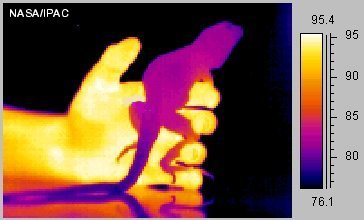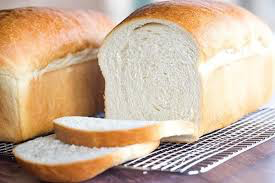Respiration
Aerobic Respiration
Respiration is the process of transferring energy from glucose. This happens in every cell, including plant cells! Respiration is exothermic, since it releases energy!
Organisms use this energy in a lot of different ways, you will need to be able to list a few:
- Animals use energy to contract their muscles. This is how we move.
- Birds and mammals use energy to keep their body temperature at the right level (lizards can’t do this so they keep warm by sunbathing).
- All organisms use energy to build larger molecules out of smaller molecules.
This is a thermal image of a lizard (cold blooded) on a human hand (warm blooded)
The human’s body is using energy to keep itself warm. The lizard cannot do this and needs to heat itself up using the sun or the hand!
There are lots of chemical reactions that take place during respiration, but you need to learn the (very very) short version of it.
There are two types of respiration:
- Aerobic respiration - which uses oxygen
- Anaerobic respiration - which doesn’t use energy
The word and symbol equations for aerobic respiration are:
Notice that these are the reverse of the photosynthesis reaction.
Anaerobic Respiration
Anaerobic respiration is still respiration, but no oxygen is involved. This doesn’t produce nearly as much energy as aerobic respiration, so this is only used as a backup (if normal respiration can’t take place)!
__ The word equation is:__
Anaerobic respiration usually happens during exercise. See the Exercise section.
Oxygen debt
When you have been exercising and anaerobically respiring, you build up an oxygen debt. This is just how much oxygen you had missed out on when you were anaerobically respiring instead of aerobically respiring. This is why you carry on breathing heavily after exercise. You’re paying your body back all the oxygen it missed out on!
Removing lactic acid after anaerobic respiration (HIGHER)
After anaerobic respiration there will be a buildup of lactic acid in your muscles. To get rid of this lactic acid, you need to provide your body with oxygen so that it can break it down into carbon dioxide and water.
Oxygen debt is the amount of oxygen that is required to safely and completely break down the lactic acid into carbon dioxide and water.
A buildup of too much lactic acid can cause a cramp in the muscle.
Anaerobic respiration in plants and yeast
Anaerobic respiration in plants and yeast produces ethanol (an alcohol) and carbon dioxide instead of lactic acid:
In yeast, this is known as fermentation! There is a big industry surrounding fermentation since yeast and alcohol are very useful in making bread and alcohol!
Exercise
Oxygen and exercise
When we exercise, the muscles are contracting more than usual. This means that they need more energy than usual. In order to get a lot of energy to our muscles, we need to take in a low of oxygen.
In order to take in more oxygen, the following happen:
- We breathe faster
- Our heart rate increases - in order to get the oxygen that’s in our blood to our cells quicker
There comes a certain point when people can’t take in enough oxygen to sustain the amount of energy they need for exercise - this is where anaerobic respiration kicks in. It allows organisms to carry on moving for a little while longer (which could be useful for a cheetah when hunting, or the antelope that’s running away)!
Metabolism
- In a cell there are hundreds of reactions happening. All of these reactions are controlled by enzymes!
- The reactions that involve molecules coming together to produce larger molecules are endothermic.
- The reactions that involve molecules breaking apart to produce more smaller molecules are exothermic.
- The overall effect of all of these reactions in the cell is called the cells metabolism.


